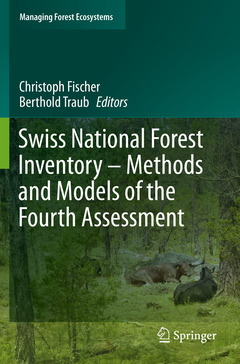Swiss National Forest Inventory – Methods and Models of the Fourth Assessment, 1st ed. 2019 Managing Forest Ecosystems Series, Vol. 35
Coordonnateurs : Fischer Christoph, Traub Berthold

The Swiss National Forest Inventory (NFI) is a forest survey on national level which started in 1982 and has already reached its 5th survey cycle (NFI5). It can be characterized as a multisource and multipurpose inventory where information is mainly collected from terrestrial field surveys using permanent sample plots. In addition, data from aerial photography, GIS and forest service questionnaires are also included.
The NFI's main objective is to provide statistically reliable and sound figures to stakeholders such as politicians, researchers, ecologists, forest service, timber industry, national and international organizations as well as to international projects such as the Forest Resources Assessment of the United Nations. For Switzerland, NFI results are typically reported on national and regional level.
State of the art methods are applied in all fields of data collection which have been proven to be of international interest and have even served as a basis for other European NFIs. The presented methods are applicable to any sample based forest inventory around the globe.
In 2001 the Swiss NFI published its methods for the first time. Since then, many methodological changes and improvements have been introduced.
This book describes the complete set of methods and revisions since NFI2. It covers various topics ranging from inventory design and statistics to remote sensing, field survey methods and modelling. It also describes data quality concepts and the software framework used for data storage, statistical analysis and result presentation.
1. Introduction; Christoph Fischer, Berthold Traub.- 2. The Swiss NFI at a glance; Urs-Beat Brändli et al.- 2.1. History and objectives.- 2.2. Legal status, obligations and organization.- 2.3. Information needs assessments and Swiss NFI impacts.- 2.4. NFI content, data collection.- 2.5. Reporting, products and services.- 2.6. References.- 3. Inventory design and statistics; Adrian Lanz et al.- 3.1. Overall design.- 3.2. Sampling design and statistical estimators.- 3.3. Spatial explicit designs.- 3.4. References.- 4. Remote Sensing; Christian Ginzler et al.- 4.1. Data sources and data assessment.- 4.2. Data management.- 4.3. 3D GIS application.- 4.4. Variables.- 4.5. Spatial products.- 4.5.1. Vegetation height model.- 4.5.2. Forest cover map.- 4.5.3. Forest type.- 4.5.4. Growing stock.- 4.6. References.- 5. Terrestrial inventory and interview survey; Fabrizio Cioldi et al.- 5.1. Planning, organization, instruction and time expenditure.-5.2. Instruments, devices and software.- 5.3. Field assessment.- 5.4. Interview survey.- 5.5. References.- 6. Modelling; Esther Thürig et al.- 6.1. Forest resources.- 6.2. Change of resources.- 6.3. Biomass.- 6.4. Other models.- 6.5. Prognosis.- 6.6. Other applications.- 6.7. References.- 7. The Swiss National Forest Inventory Data Analysis System NAFIDAS; Berthold Traub et al.- 7.1. Databases.- 7.2. Web application.- 7.3. Statistical analyses.- 7.4. References.- 8. Data Quality; Berthold Traub et al.- 8.1. Field survey and road survey.- 8.1.1. Field manual consistency and training of field groups.- 8.1.2. Control assessment and re-measurements.- 8.1.3. Forest road survey.- 8.1.4. MAIRA plausibility checks.- 8.2. Aerial imagery interpretation.- 8.3. References.- 9. Appendix; Christoph Fischer et al.- 9.1. Estimators and derivations.- 9.2. Parameters of volume functions, tariffs.- 10. Glossary; Markus Huber et al.- 11. Index
Comprises detailed description of all facets of a National Forest Inventory, ranging from organizational and methodological aspects to technical details of sampling designs and statistical results analyses
Presents prognosis models and wall to wall spatial products such as the vegetation height model
Shows the whole automatized workflow from raw data acquisition to statistical estimation and results presentation
Explains data warehousing concepts and architecture, and discusses appropriate concepts of result dissemination via web-based tools.
Describes quality assurance and control measures applied to the terrestrial field surveys and aerial photo interpretation in detail
The presented methods are applicable to any sample based forest inventory around the globe
Date de parution : 10-2020
Ouvrage de 431 p.
15.5x23.5 cm
Date de parution : 10-2019
Ouvrage de 431 p.
15.5x23.5 cm



